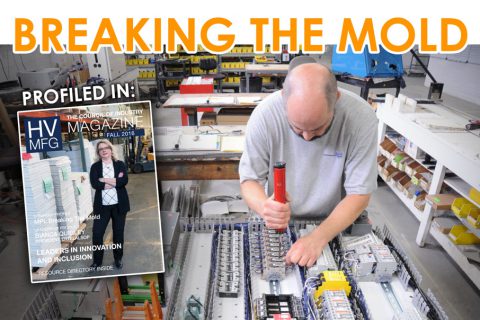Investment Casting – MPI’s Breaking the Mold
As published in The Council of Industry Magazine and Manufacturing Resource Guide
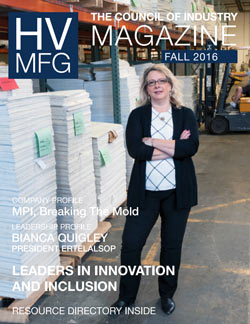
The process of investment casting has several steps, but is much simpler, faster, and more precise than creating each product by hand. An artist (or design engineer) creates an original pattern which can be quite intricate and detailed. In order to replicate this part, a die is made which is a negative of the final part. This is filled with wax. The wax part is then removed from the die. It is during this vital step in the process that it is critical to ensure all the undercutting and fine detail is preserved. The wax pattern is then dipped in ceramic to create a smooth and highly accurate ceramic shell. When the ceramic is fired, the wax melts out, and molten metal is then poured into the ceramic shell. The metal hardens and the shell is broken away to reveal the final product, an exact replica of the original pattern. This process actually takes place in the foundry at the customer’s facility, not at MPI. MPI, Inc. designs and builds the machines that control the wax injection process and while most of us imagine this process being used to make large objects it is, in fact, also a process that is effectively used to make smaller, precise items used in the aerospace, automotive and energy industries.
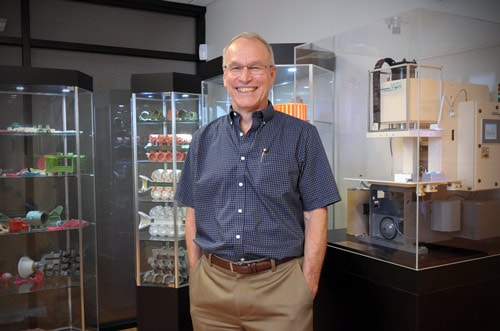
Bruce Phipps standing in front of a scale model of a machine built by Mark Sacher, an engineer at MPI.
MPI, Inc. was founded in 1968 as Mueller Injection Presses, by Hans Mueller manufacturer of the “Sherwood Wax Injector.” In 1972 Bruce Phipps and his then partner, Fred Mueller (Hans’ nephew) purchased the company changing the name to Mueller – Phipps International Inc. and in 1974 began producing a machine of their own design. By 1984, the partners had a difference of opinion about the direction the company should go, leading Phipps to purchase the company outright becoming sole owner and president and be able to focus on the Investment Casting industry. The name was changed to MPI Incorporated and the company relocated to the manufacturing facility where they currently operate on Smith Street in the city of Poughkeepsie. They became the first in the industry to introduce paste wax, new designs for frames, and other innovations.
The next water mark for the MPI came in 1999 when the company received a grant from NYSERDA to develop their wax welding process. This process would reduce both the energy used by their machines and the amount of wax scrap produced. “This was a big breakthrough for us.” said MPI President and Founder Bruce Phipps. “The NYSERDA funding directly lead to the development and installation of our first APAS (Automated Pattern Assembly System) in 2004. We went from building manually operated equipment to computer controlled systems.”
From there the process innovations from MPI accelerated. By 2006 MPI introduced “Smart Controls” which include a touch screen. With 60% of MPI’s machines shipped overseas each year the screen includes a variety of language options to allow for international use. In 2010 the company began shipping the first Automated Injection Cell and in 2012, the first Automated Single Crystal Assembly Cell, which is used in the manufacture of jet engine blades.
Next for MPI was the integration of robotics into their wax room solutions for customers. MPI is a certified integrator for ABB and Fanuc six (6) axis robots which are part of the automated cells. “Now MPI can even put together a fully automated wax room,” explained Phipps. “As the leader of wax room innovations, MPI has developed and introduced more systems and products than all of our competition combined.”
Such innovation is the direct result of the efforts of a highly skilled and dedicated team. “I am always proud and amazed by what our people are capable of,” added Phipps. “We have customers who believe in us enough to bring us some challenging problems to help them solve and even if we have never done it before we have been able to design solutions for them, to build new products for them.”
Along with this product development the company has expanded as well, from the early days in a 2,400 sq. ft. space, to the current 47,500 sq. ft. state of the art facility that also houses a fully functioning laboratory and showroom where MPI’s state of the art wax room equipment can be demonstrated to clients. Customers occasionally come to MPI for testing to find the perfect wax mixture or the most efficient way to produce a part. The machines are not made for mass production of cheap parts but for large scale production of high quality parts for very specific uses.
MPI Inc.’s machines will travel to companies across the United States and more than half will travel overseas to become part of production lines for aerospace, automotive, commercial and medical companies. At any time the facility has a variety of machines being assembled that will eventually be part of a production line manufacturing turbine blades, medical implants, turbo wheels, and even parts for food processing equipment. Phipps recalls the MPI’s first business deal in China, “We sold our first machine there and I thought that would be it. Now that is one of the biggest markets for our equipment.” The companies purchasing MPI Inc. machines are high end, dealing in western technology like Pratt & Whitney Aircraft (USA), Rolls Royce PLC (UK, Italy, China), Hitachi Ltd. (Japan), Texmo Precision Casting (India), Zollern (Germany), Stryker (Ireland & USA), Master Power (Brazil), and Avignon Ceramiques (France) just to name a few.
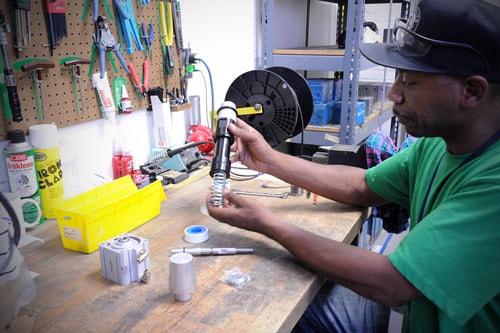
Paul Hunt is assembling an injection nozzle.
The workforce at MPI is really a group of problem solvers, including mechanical engineers, electrical engineers, computer engineers and people that like to take things apart and put them back together. MPI employees travel with the machines to set them up for customers and then train operators on the proper use and maintenance of each machine. When companies hire new operators they can be sent to MPI for training or request a training session at their facility. MPI also conducts training for its own employees in various areas from LEAN manufacturing to the Council of Industry’s Certificate in Manufacturing Leadership training. MPI has also hosted tours for Certified Production Technicians from the local community college programs.
“I give personal foundry tours to our people—engineers, subassembly, and assembly—so they really understand what our customer base does with our products. They meet machine operators, department managers, engineers, and the service technicians who handle the problems. We exchange ideas and work together in a very positive environment. Those trips allow our employees to interact in a meaningful way,” explains Phipps. The employees at MPI Inc. produce between 60 and 80 machines a year and while there are some standard designs the models are highly customizable with numerous options.
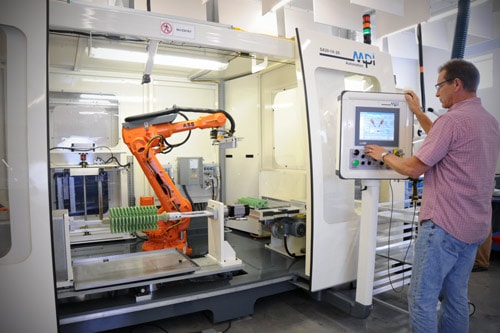
Machine operator programming the APAS (Automated Pattern Assembly System).
The future of investment casting involves automation and robots. The first Automated Pattern Assembly machines were purchased in 2004 by aerospace, golf, firearms, and commercial companies. Today MPI’s automated injection cells are equipped with their wax injector along with a variety of secondary systems including a pattern/ core conveyor, automatic tool change station, and six-axis robot. When designing the automated wax room, Phipps explains how “MPI has incorporated the best process controls into every automated function from inserting ceramic cores, wax injection, and pattern removal to pattern setting, injection runner trimming and inspection, and so on.” Automation is an area that many companies in investment casting are still just looking into. MPI is already there. In fact MPI has consistently proven that an automated process can out perform operator controlled injection and assemblies in accuracy, repeatability, and efficiency.
MPI Inc. has become the successful company it is today because of the drive to innovate and improve. William Pollard, a 19th century minister, said, “Without change there is no innovation, creativity, or incentive for improvement. Those who initiate change will have a better opportunity to manage the change that is inevitable.” By embracing the automation in investment casting MPI has taken the reins of the inevitable evolution of the industry and is leading the way. By developing cutting edge machines and setting the industry standards for training and customer service, MPI is breaking the mold of the investment casting industry and creating a new pattern all their own.
CLICK HERE TO DOWNLOAD A PDF OF THE MAGAZINE PROFILE

